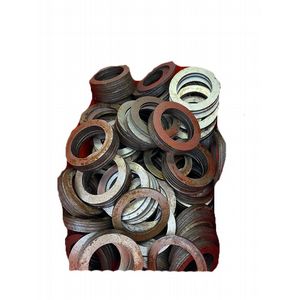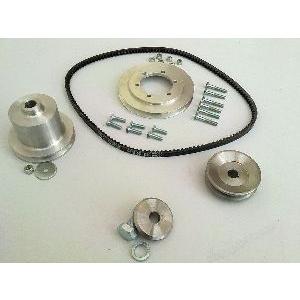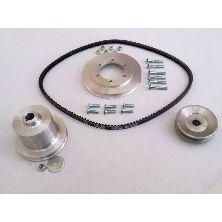This kit allows the use of a thin fan belt with either an original dynamo, or an alternator.
The kit includes aluminium pulleys for the crankshaft and the water pump as well as a pulley for the dynamo or alternator with an integral fan.
The original fat fan belt has a tendency to over strain the water pump pulley resulting in the pulley becoming detached from the water pump spindle. A thin fan belt will reduce this tendency.
The conversion also offers the (rather obvious) advantage of replacement belts being much easier to purchase if caught out whilst travelling.
The kit includes a bolt and washer to allow the removal of the original fan or fan hub. If on the other hand you wish to retain the original fan and hub, then order RTR1210K.
A word about Harmonic dampers versus solid machined crank pullets
We don t usually use Harmonic dampers on the crank. If one is fitted to an engine we are working on and it is not giving problems we will leave it there.
I have raced my TR2 for over 30 years with a standard type crank without a rubber mounted pulley. I recon I have done 200,000 miles in the car a lot of which would be racing, hill climbs, sprints, rallies as well as fast road work and I haven t had a problem yet. The issue as I see it is that engine manufacturers go to a lot of trouble to design a harmonic balancer when an engine is designed to get rid of unwanted harmonics. Here is the clue; harmonics are frequency dependent so the damper has to eliminate specific frequencies.
Obviously not all engines produce the same harmonics and therefor one damper does not fit all. For more information click the 'FAQ' tab
Neil Revington
This part is listed on the following page of the website, where further information and background reading may be found.
Engine, Transmission, wheels/Tyres and Heating/Cooling »
THIN BELT CONVERSIONS AND HARMONIC DAMPERS
Q: Does the 4 cylinder TR engine require an harmonic balancer on the front of the engine?
A:
The subject of balancers needs careful consideration. You can be sure that when BMW specify a harmonic balancer for a new engine they don't have an engineer thumbing through a catalogue over a cup of tea looking for one that might just fit- sort of - if modified a bit. It would be more realistic to assume thousands of hours of testing goes into the design for each application.
RevingtonTR have close contacts with a vibration specialist company who have designed a suitable damper for 4 cylinder TR use but agree with us that this only has a primary value above 5000 rpm. We use this damper when we install a billet crank into an engine that will reliably and continually run at 7500rpm. The company in question do work for Bentley so I think it is fair to assume they know what they are talking about. This damper needless to say is intended for use only where the engine fan has been removed.
By contrast Neil Revington's TR2 has no damper on the front of the engine. This engine uses a standard crank and rods and has been used in competition and on the road for over 200,000 miles, much of which will have been at high revs, up to 6500 at times. It suffers no vibration and the engine is as smooth as the day it was built. Neil designed our aluminium pulley over 20 years ago which has been fitted to hundreds of engines built for road and competition use. We have had no complaints of torsional vibration that would need eliminating with a harmonic balancer. Coupled to this we have sold many hundreds of thin fan belt conversion kits incorporating out aluminium crank pulley all over the world with no negative feedback about vibration. Most of these kits are sold with an electric fan indicating their use without the engine fan fitted. It is naive to think the fan fitted to the front of a 4 cylinder TR engine is in some way a damper. The fan is a crude device and its design and the manner in which it is attached to the engine gives no suggestion of it having any anti vibration design intent. It is interesting to consider that the TR250-6 fan is mounted on its crankshaft with an harmonic damper using the exact same part number small rubber bushes that TR's 2-4A use reinforcing the conclusion that they are there to try to prevent vibration being introduced by the fan, not as some form of harmonic balancing of the engines internal components.
Technical speak
A harmonic damper is a device fitted to the front (assuming the drive to the wheels is from the rear) end of the crankshaft of an internal combustion engine. It is essential in engines with long crankshafts (such as straight 6 and straight 8 engines) and is present on most engines as it reduces torsional vibrations that tend to peak at certain speeds. Torsional vibrations can greatly reduce crankshaft life, if not cause instantaneous failure, if the crankshaft runs at or through an internally generated resonance. Because of this, dampers are designed with a specific weight and diameter to reduce mechanical Q factor[1] and therefore damp out crankshaft resonances. Manufacturers will often re-size the damper in the same basic engine when modification to crankshaft material, thickness, weight, or throw is implemented. Even piston size and conrod shape/weight can affect the damper requirement. With this in mind it is clear that dampers are very specific to an individual engine application and cannot with reliability be simply lifted from one application to another without first understanding the characteristics of the donor engine and matching that to the TR engine. It may also be argued that as the TR engine in question is a well-designed 4 cylinder with a massive and stiff crankshaft, that Triumph (who were not stupid and were at the time one of the foremost manufacturers of sports and saloon cars in the world) will have measured all this and concluded a damper was not necessary (Admittedly the bean counters would have had an input into this too!). Bear in mind that Triumph at the same time produced a very successful 6 cylinder engine on which they conclude a damper was necessary.
It is worth noting that early TR conversions to a thin fan belt arrangement used a pulley of another engine, notably an MGB, primarily due to ease of availability and relatively easy adaption to fit the TR2-4A engine. The fact that these dampers are harmonic dampers for their original application is of no relevance in the TR application. Another important consideration is that Triumph for commercial reasons applied limited balancing to their engine construction. Few engines fitted to TR's 2-4A these days will have escaped being rebuilt. This may have been done to a wide range of standards from good to downright appalling. These engines will produce vibration for a number of reasons some of which will be, but not limited to, rotational lack of balance, reciprocating balance and combustion balance. Added to that with twin carburettors an out of balance of the fuel delivery will introduce vibration. None of these vibrations are inherent torsional vibration needing a harmonic balancer. Consequently when an engine has been built correctly and balanced correctly it will be joyously noted that a harmonic balancer is not necessary!
So our conclusion is that the 4 cylinder TR engine does not need a harmonic damper when it is either a standard unit or one constructed with improved but mostly standard components (crank and rods especially) and used within or slightly beyond its designed rev range, especially when the unit had been carefully built and balanced. However, when a different crank, typically a billet crank, is used in conjunction with ʽHʼ or ʽIʼ beam con rods in an engine revving to 7500 rpm then an harmonic balance will be beneficial to some extent but this will be a little bit 'hit or miss' for the reasons stated above vis a vis the amplitude and specific rev range of the harmonics (if any).
[1] In physics and engineering the Quality factor or Q factor is a dimensionless parameter that describes how under-damped an oscillator or resonator is and characterizes a resonator's bandwidth relative to its centre frequency. Higher Q indicates a lower rate of energy loss relative to the stored energy of the resonator; the oscillations die out more slowly.
Kind Regards




